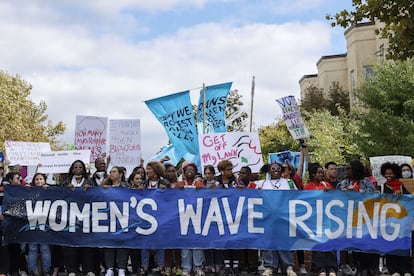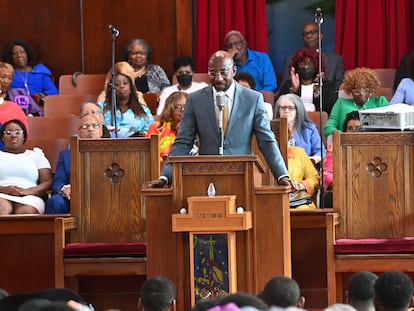Inflation, abortion, security: How parties are courting women’s vote in the US
Both Democrats and Republicans are eager to win over this large and consistent voting bloc, which will be a decisive factor at the midterm elections on November 8


The noontime rally had yet to begin but Folger Park, a few blocks from the US Capitol in Washington, DC, was already teeming with women. The organizers of the Women’s March had been expecting about 2,000 participants, and it looked like that number would be easily exceeded. The marchers were asked to wear blue, but some chose green instead – the color symbolizing women’s reproductive rights that was first popularized in Argentina and later spread throughout the continent. Women of all ages shook off the October chill and hoisted banners bearing slogans: “United we are stronger than a divided country – Vote!”
They streamed into the park from all directions. Silver-haired women flanked by their daughters and granddaughters; young people just old enough to vote in the November elections; wide-eyed teenagers too young to vote carrying homemade signs – “I can’t make my own decisions, but I can have a child?” – came to their first ever protest march. The crowd started heading toward the Capitol Building, chanting, “When women’s lives are under attack, what do we do? Stand up and fight back!” A man stepped in front of the marchers and shouted, “Sinners! You’re all going to hell!”. He was promptly surrounded by women and shunted to the sidelines where he hurled insults during the hour-long rally.
“I was never really interested in politics, to tell you the truth – it bored me. But I was shocked that they’re taking away our right to an abortion. I hadn’t paid much attention until now, but it’s about protecting our rights as women. Now I’m really paying attention,” said Robbie, a 20-year-old student from Maryland attending the rally with a group of friends. She said she is “outraged” by the Supreme Court’s decision in June to overturn the 1973 Roe v. Wade ruling that affirmed the Constitutional right to an abortion. Now each individual state must decide whether to allow voluntary termination of pregnancies and under what conditions. Would she vote on November 8? “Of course,” replied Robbie. “Our bodies are at stake.”
According to census data, women make up 27% of the total electorate, and cast 30% of all the votes in 2018 and 2020
In Arlington County (Virginia), across the Potomac River from Washington, DC, Anne complained about inflation – 8.2% in September. The 57-year-old service company worker and mother of two college-age children said, “We can’t buy the things we used to get. I have to think twice about what I put in my shopping basket now. I hardly ever buy fish, and I cut back on meat as well. I go to a supermarket that’s further away, but a little cheaper. I work from home whenever I can, so I don’t waste gas. You try to do more with less... that’s my main concern right now,” she said.
The US midterm elections are just a couple of weeks away, and no one questions its significance. Command of both houses of Congress hangs in the balance, and the party that wins will control the legislative agenda of a politically polarized country. Women – one of the largest voting blocs in the US – will be decisive in many races. There are 10 million more registered female voters than male voters, and they also turn out at the ballot boxes more consistently than men. In the 2020 presidential election, 88.2 million women voted, compared to 72.5 million men. Their support in 2018 gave the Democratic Party a majority in Congress, and in 2020, women voters propelled Joe Biden to the presidency by a margin of seven million popular votes over Donald Trump.
“Gender is a significant factor in voting behavior and for voter mobilization efforts,” said Emory University (Atlanta, Georgia) Professor Andra Gillespie. “Some segments of women voters could be decisive in some of the electoral battles. For example, African American voters are disproportionately female. A large turnout of African American women could be good news for Democratic candidates, because that bloc is consistently loyal to the Democrats.”
What issues will mobilize the most women to vote? Defending the right to an abortion would benefit the Democrats, while concern about the deteriorating economy and the rising cost of living could favor Republican candidates. A recent University of Pennsylvania poll indicated that 41% of American voters, both men and women, consider inflation the most pressing issue, while only 15% think abortion rights is a high priority.
In the weeks following the Supreme Court’s overturning of Roe v. Wade, non-governmental organizations dedicated to voter mobilization saw a huge increase in female voter registrations. In Michigan, twice as many women than men registered to vote, while in Pennsylvania, women account for 56% of new voter registrations since June 24. Women voters in Kansas dealt a resounding defeat to a proposed law that would have banned abortions in almost every circumstance.
“Abortion is a highly motivating issue on its own, but also because it’s closely connected to other issues of economic justice and racial inequality in our country,” said Amanda Brown Lierman, who heads Supermajority, an organization focused on mobilizing women voters. “We’ve found that women are very motivated about this issue, and about our future rights. Our lives and our bodies are on the line.”
The Democratic Party has made abortion rights the central issue in these elections, especially in closely contested states like Pennsylvania, Michigan and Georgia. President Biden promised in mid-October that he would ask lawmakers to codify the abortion rights protections in the Roe v. Wade decision if Democrats retain control of Congress.
“The Democrats are betting that college-educated white women, who historically have voted more for Republicans [though in 2018 and 2020 they tilted toward the Democrats], will find the current abortion situation unacceptable and decide to vote for pro-choice candidates,” said Gillespie.
The polls say that freedom of choice and women’s rights are the top issues for women under 35. But the top concerns for women over 50 are the dramatic rise in the cost of living, the direction of the economy and security: 66% say they have cut back on non-essential spending this year. “The issues that motivate women to vote are varied because they are not a monolithic bloc,” notes Amanda Brown Lierman.
Warning signs
Recent polls have alarmed some Democrats after weeks of forecasting strong support for Democrats from independent women (not registered with either party). A New York Times poll found a dramatic swing in these independents who previously favored Democrats by 18 percentage points – they are now leaning Republican by 14 percentage points.
“I work from home and can’t afford to retire because inflation has pushed prices so high. I’m paying twice as much as I used to for groceries. At least I don’t have to spend money on gas working from home,” said a 64-year-old Ohio woman at a focus group organized by the American Association of Retired Persons (AARP). “Prices have gone up so much that I can’t afford to be the kind of grandmother I’d like to be. I have an 18-month-old granddaughter and my son wanted me to say hello on a Zoom video call. But I had to work – I couldn’t afford to lose the $20 pay for that hour. I hung up the phone and burst into tears.”

Voters like the Ohio grandmother are critical to both parties. Women over 50 comprise one of the largest and most consistent groups of voters. According to census data, they make up 27% of the total electorate, and cast 30% of all the votes in 2018 and 2020. An AARP survey indicates that 94% of them plan to vote this year, but half are still undecided; 78% of Latina women are also undecided.
“As the largest bloc of swing voters in this election, women over 50 can make a difference in 2022 and determine the balance of power in Congress and in states all over the country,” said AARP’s Nancy LeaMond.
The last few weeks before the election will be critical. Two in five women over 50 say they will decide who to support in the days leading up to November 8. We will also see how many of the less-consistent women under 35 will ultimately turn out to vote.
“This is going to be a congressional election like no other. American mothers are determined to vote,” said Kristin Rowe-Finkbeiner, executive director of MomsRising. “Women and mothers have registered to vote in record numbers, and we are doing a tremendous amount of work to get them involved. We’re going to exercise our power at the polls this year.”
Tu suscripción se está usando en otro dispositivo
¿Quieres añadir otro usuario a tu suscripción?
Si continúas leyendo en este dispositivo, no se podrá leer en el otro.
FlechaTu suscripción se está usando en otro dispositivo y solo puedes acceder a EL PAÍS desde un dispositivo a la vez.
Si quieres compartir tu cuenta, cambia tu suscripción a la modalidad Premium, así podrás añadir otro usuario. Cada uno accederá con su propia cuenta de email, lo que os permitirá personalizar vuestra experiencia en EL PAÍS.
¿Tienes una suscripción de empresa? Accede aquí para contratar más cuentas.
En el caso de no saber quién está usando tu cuenta, te recomendamos cambiar tu contraseña aquí.
Si decides continuar compartiendo tu cuenta, este mensaje se mostrará en tu dispositivo y en el de la otra persona que está usando tu cuenta de forma indefinida, afectando a tu experiencia de lectura. Puedes consultar aquí los términos y condiciones de la suscripción digital.
More information
Archived In
Últimas noticias
Maduro pleads not guilty before the federal court in New York: ‘I am still the president of Venezuela’
A new test can detect Alzheimer’s from a finger prick
UN team enters Sudanese city of El Fasher after paramilitary massacre: ‘It’s like a ghost town’
A recipe for resistance: Indigenous peoples politicize their struggles from the kitchen
Most viewed
- Gilles Lipovetsky: ‘If you want to live better and fall in love, take Prozac, don’t look to philosophy’
- Alain Aspect, Nobel laureate in physics: ‘Einstein was so smart that he would have had to recognize quantum entanglement’
- Alvin Hellerstein, a 92-year-old judge appointed by Bill Clinton, to preside over Maduro’s trial in New York
- Why oil has been at the center of Venezuela-US conflicts for decades
- Maduro’s downfall puts China’s relationship with Venezuela to the test










































